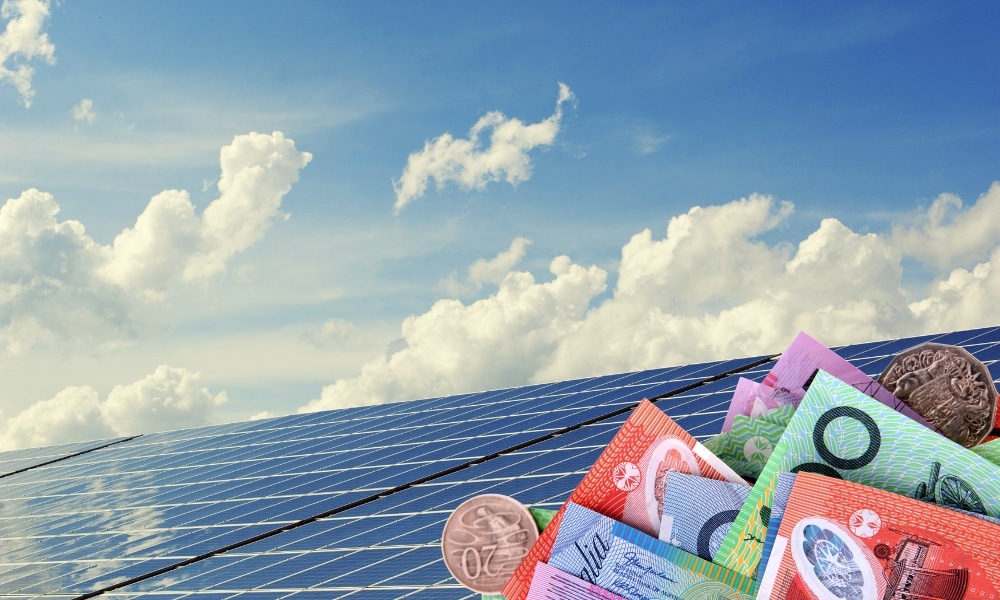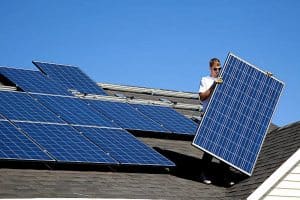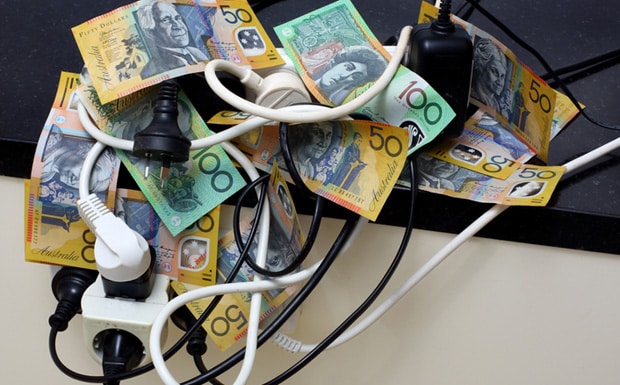Before you can bask in the benefits of solar power, there’s an important decision to make: how to finance your solar panels. In this comprehensive guide, we’ll explore the ins and outs of buying solar panels outright, taking out solar loans, financing solar panels and opting for solar leases or Power Purchase Agreements (PPAs), to help you find the best path to solar for your situation.
Buying solar panels outright
Purchasing solar panels with cash upfront is the most straightforward path to owning a solar power system. This option allows you to become the full owner of the system from day one, granting you complete control over it and making you eligible for various government rebates and incentives.
Benefits
- Immediate ownership: When you buy your solar panels outright, you own the system immediately. This means you have full control over it and can benefit from all the electricity it generates without having to make ongoing payments.
- Government rebates and incentives: Australia offers several government incentives to encourage solar energy adoption, such as the Small-scale Renewable Energy Scheme (SRES). Purchasing your system outright allows you to take full advantage of these incentives, significantly reducing the initial cost of your solar installation.
- Quicker return on investment (ROI): Without the burden of interest payments, your savings on electricity bills start paying off the cost of your solar system from day one. Over time, the savings can completely cover the cost of your investment, leading to free electricity for the remaining life of the system.
Considerations
- Upfront cost: The most significant barrier to buying solar panels outright is the initial cost. While prices have decreased significantly over the years, a quality solar power system still requires a substantial investment.
- Maintenance and repairs: Ownership means responsibility. You’ll need to manage any maintenance or repairs that your system requires. However, many solar panels come with long-term warranties that can cover most issues.
In Australia, taking advantage of the sunny climate with a solar system offers not just environmental benefits but also considerable savings on energy bills in the long run. Buying your solar panels outright can be a smart financial decision if you have the upfront capital to invest. Not only does this option maximise the financial returns by avoiding interest and maximising government incentives, but it also puts you in direct control of your energy future.
As we continue to delve into the financing options available for solar panels in Australia, keep these benefits and considerations in mind. Each financing route offers unique advantages and challenges, and the best choice depends on your personal financial situation, energy needs, and long-term plans. Stay tuned as we explore solar loans in the next section, offering another path to harnessing Australia’s abundant sunshine.
Solar loans
For those not in a position to pay the full price upfront for solar panels, solar loans present an attractive alternative. Similar to other types of loans, a solar loan can be secured against an asset (usually your home) or unsecured, which typically affects the interest rate and terms of the loan.
Benefits
- Immediate ownership: Like buying outright, financing through a solar loan means you own the system from the start. This ownership allows you to benefit from government rebates and incentives available in Australia, such as feed-in tariffs for the surplus energy you produce.
- Spread the cost over time: A loan allows you to spread the substantial cost of solar panels over several years, making solar energy accessible without a large initial outlay. This way, the savings on your electricity bills can go towards paying off the loan.
- Flexibility: Solar loans offer a range of terms and interest rates, depending on factors like the loan amount and your credit history. Some Australian banks and credit unions even offer green loans with lower interest rates for environmentally friendly investments like solar panels.
Considerations
- Interest rates: Depending on the terms of your loan, the interest rate can significantly impact the overall cost of your solar system and the time it takes to see a return on your investment.
- Loan terms: The length of your loan term will affect both your monthly payments and the total interest paid over the life of the loan. It’s essential to find a balance that fits your financial situation.
When considering a solar loan, it’s a good idea to get multiple quotes for solar to understand the options and find the best deal. Look for loans specifically designed for solar financing, as they may offer better terms and interest rates compared to general personal loans.
Financing Solar Panels
In addition to buying outright, taking out solar loans, and opting for solar leases or Power Purchase Agreements (PPAs), financing stands out as a prevalent method for acquiring solar panels in Australia. Financing solar panels is distinct from solar loans in several key aspects, including fixed payments, zero upfront costs, and typically shorter payback terms. This method caters to homeowners and businesses looking for an immediate path to solar energy without the significant initial investment.
Benefits
- Cash-Flow Positive: One of the most attractive features of financing your solar system is the potential to be cash-flow positive from your very first electricity bill. The savings generated from your reduced electricity bill can often cover the fixed monthly repayments, making this an economically viable option from the outset.
- Zero Upfront Costs: Financing allows you to install a solar system without any upfront payment, removing a significant barrier to entry for many households and businesses.
- Shorter Payback Terms: Compared to other methods, financing often comes with shorter payback terms, enabling quicker ownership and less financial commitment over time.
Considerations
- Merchant Fees: While financing offers a straightforward path to owning a solar system, it’s important to note that there is usually a merchant fee built into the repayments. This means you might end up paying slightly more for your system over the term of the financing agreement compared to purchasing it outright.
- Overall Cost: Despite the higher total cost due to merchant fees, financing remains a popular choice for many Australians. It’s second only to cash payments, largely because of its immediate financial benefits and the ability to start saving on electricity costs right away.
Financing your solar panels is an excellent option for those who prefer not to pay the full price upfront and who wish to enjoy the benefits of solar energy without the significant initial outlay. It’s a flexible solution that can suit a wide range of financial situations, making solar power more accessible to a broader audience.
Solar leases and Power Purchase Agreements (PPAs)
Solar leases and PPAs offer another path to solar energy, ideal for those who prefer not to own the system outright or take out a loan. Both options allow you to have solar panels installed on your property with little to no upfront cost, but there are key differences.
- Solar leases: You agree to lease the solar system from a provider for a set period, typically 10-20 years. You pay a fixed monthly lease payment, which is usually lower than your current electricity bill, and get to use all the electricity the system produces.
- Power Purchase Agreements (PPAs): Instead of leasing the equipment, you agree to purchase the power generated by the solar panels at a set rate per kWh, which is often lower than the retail electricity rate. The solar company owns, installs, and maintains the system.
Benefits
- No or low upfront costs: Both options eliminate the barrier of the initial investment, making solar power accessible to more people.
- Maintenance included: The leasing company or PPA provider is typically responsible for the maintenance and repairs of the solar system, reducing the hassle for you.
- Immediate savings: Since the monthly payments or the PPA rate are usually lower than your current electricity bill, you can start saving money right away.
Considerations
- No ownership: You don’t own the system, meaning you won’t benefit from government incentives and rebates. At the end of the lease or PPA term, you may have the option to purchase the system, renew the agreement, or have it removed.
- Long-term agreement: Leases and PPAs usually lock you into long-term contracts, which can be a disadvantage if the rates become less competitive over time or if you wish to sell your property.
Solar leases and PPAs can be excellent options for accessing solar energy with minimal financial commitment. However, the long-term nature of these agreements and the lack of ownership mean they may not suit everyone. As with any financial decision, it’s important to consider your long-term plans and compare all options before deciding.
Comparing the Options
When it comes to financing solar panels in Australia, the best choice depends on your individual circumstances, including your financial situation, energy needs, and long-term plans. Let’s take a closer look at how buying outright, solar loans, and solar leases or PPAs stack up against each other.
| Financing Option | Upfront Costs | Long-term Savings | Maintenance Responsibilities | Contract Flexibility |
| Purchase Outright | High | Highest | Owner’s responsibility | High flexibility |
| Solar Loans | Low to Medium | High | Owner’s responsibility | Medium flexibility |
| Leases/PPAs | None to Low | Moderate | Covered by provider | Low flexibility |
- Upfront costs: Buying outright requires a significant initial investment but offers the highest long-term savings. Solar loans spread this cost over time, making solar panels more accessible with manageable monthly payments. Leases and PPAs have little to no upfront costs, appealing to those who prefer not to invest a large sum upfront or take on debt.
- Long-term savings: Purchasing solar panels outright typically results in the greatest savings over the life of the system, as you avoid interest payments and benefit fully from lower electricity bills. Solar loans also lead to considerable savings, though total savings are slightly reduced by interest payments. Leases and PPAs offer immediate savings on electricity bills but generally result in lower total savings over the contract term.
- Maintenance responsibilities: Owners of solar panels are responsible for maintenance and repairs, though warranties cover many issues. Leasing companies and PPA providers handle maintenance, offering peace of mind but less control over the system.
- Contract flexibility: Buying outright or with a loan provides more flexibility, as you own the system and can decide on upgrades or additional panels. Leases and PPAs bind you to a longer-term agreement, which might limit flexibility but offers stability in payments and maintenance.
For detailed comparisons and to understand how different solar panel sizes affect your energy production and finances, getting multiple quotes can be invaluable. It’s also wise to consult with a financial advisor or solar consultant to explore which option aligns best with your personal and financial goals.
Navigating government incentives and rebates
Australia’s government offers a variety of incentives and rebates to encourage the adoption of solar energy, which can significantly impact your decision on how to finance your solar panels.
Federal incentives
The Small-scale Renewable Energy Scheme (SRES) provides certificates for eligible solar panel installations, which can be sold to recoup a portion of the installation cost. This incentive is available to homeowners, businesses, and community groups across Australia who buy their solar systems outright or through a loan.
State-specific rebates
Many states and territories offer additional incentives, such as rebates or feed-in tariffs for excess electricity fed back into the grid. These can further reduce the cost of going solar and increase the financial return on your investment.
Eligibility
To maximise these incentives, understanding the specific eligibility criteria is crucial. Generally, owning your solar system outright or through a loan makes you eligible for most incentives. In contrast, solar leases and PPAs often do not qualify for government rebates, as the system is not owned by the resident.
Navigating the landscape of government incentives and rebates can be complex, but it’s worth the effort to ensure you’re taking full advantage of the available support. Checking the Clean Energy Council and local government websites can provide up-to-date information on the incentives you may be eligible for. Additionally, consulting with a knowledgeable solar provider can help simplify the process and ensure you’re getting the best value for your investment.
Choosing the right financing option for your solar panels involves weighing upfront costs, long-term savings, maintenance responsibilities, and the flexibility of your contract. By considering these factors alongside the available government incentives and rebates, you can make an informed decision that suits your financial situation and energy needs, bringing you one step closer to enjoying the benefits of solar energy in Australia.
Final considerations before making a decision
Deciding on the best way to finance your solar panels in Australia is a significant decision that goes beyond comparing costs and savings. Here are some final considerations to keep in mind before making your choice:
Energy needs
Evaluate your current and future energy consumption. Installing a solar system that meets your energy needs now and in the foreseeable future is crucial. Consider changes such as family size, home additions, or purchasing an electric vehicle that may affect your electricity usage.
Solar system quality and warranty
Not all solar panels and inverters are created equal. Research different brands, their efficiency rates, warranty periods, and what they cover. Higher quality systems may cost more upfront but can offer better performance and longer lifespans, leading to greater savings in the long run.
Consult with experts
Speak with solar energy consultants or financial advisors who can provide personalised advice based on your financial situation and energy goals. They can help you navigate the complexities of solar financing and government incentives.
Roof suitability and location
Ensure your roof is suitable for solar panel installation and has adequate exposure to sunlight. Factors like roof condition, shading, and orientation can significantly impact the efficiency of your solar power system.
By carefully considering these factors, you can make an informed decision that aligns with your financial and energy needs, ensuring that your investment in solar energy is both sustainable and cost-effective.
Conclusion
Financing your solar panels is a critical step towards harnessing Australia’s abundant sunshine for your energy needs. Whether you choose to buy your solar system outright, take out a solar loan, or opt for a lease or PPA, each option offers its unique advantages and considerations. By understanding the upfront costs, long-term savings, maintenance responsibilities, and flexibility of each option, along with the available government incentives, you can make an informed decision that suits your financial situation and sustainability goals.
Remember, investing in solar energy is not just about reducing your electricity bills; it’s also about contributing to a greener, more sustainable future for Australia. With careful planning and the right financing choice, you can enjoy the benefits of solar energy for years to come.
Frequently Asked Questions
How long does it take for solar panels to pay for themselves?
The payback period for solar panels in Australia varies depending on factors such as the cost of the system, financing option chosen, energy consumption, and electricity rates. On average, it can take anywhere from 3 to 7 years for a solar system to pay for itself.
Can I increase the size of my solar system later?
Yes, most solar systems can be expanded in the future. However, it’s important to plan for this from the start, ensuring your inverter can handle the increased capacity and that there’s enough space on your roof for additional panels.
Are solar panels still effective on cloudy days?
Yes, solar panels can still generate electricity on cloudy days, though their efficiency is reduced compared to sunny days. The overall impact on your solar energy production depends on the specific climate and weather patterns of your location.
What happens to the excess electricity generated by my solar panels?
Excess electricity can be fed back into the grid. In many parts of Australia, you may receive a feed-in tariff for this surplus energy, providing additional savings or income.












































